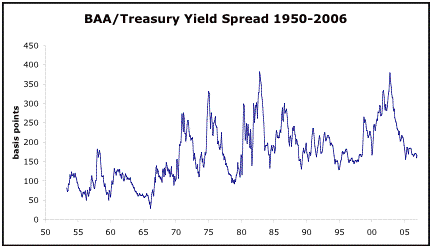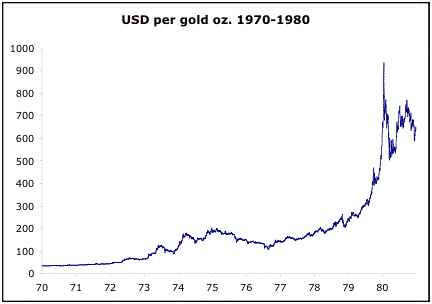Inflationary Recessions 2: You Don’t Go Bust In An Inflation
January 27, 2007
We’ve been looking at the idea of inflationary recessions lately. First of all, what is a recession? All of the technical definitions, such as “two negative GDP quarters” are rather poor. We all recognize a recession as a period of economic deterioration. I would suggest that our collective notion of a recession includes default, bankruptcy, and job loss, with the Great Depression the formative experience in this regard, in the Western industrialized countries.
Someone living in Latin America may have a different notion of a “recession.” Places like Peru or Argentina have experienced several episodes of extreme inflation over the past fifty or a hundred years. In an extreme inflation, characterized by prices rising 30% or more per year (at times in excess of 100%), you generally don’t have default, bankruptcy and job loss. A default means you can’t make your payments on obligations. However, as a currency cheapens, it becomes easier and easier to make payments, to the extent that the currency decline/inflation is unexpected an not reflected in prior interest rates. Default is just the step before bankruptcy, so you generally don’t see bankruptcy either.
Both default and bankruptcy are singularities. They change the process of business overnight. Business may liquidate or have to alter their cost structure dramatically and quickly. Creditors, such as banks, may find that they are also thrown into turmoil by the bankruptcy of a debtor, as bad debts pile up. Banks threaten to topple and collapse. They then restrict lending, fearing any more nasty surprises, which in turn creates more consequences. This environment tends to lead to job loss.
For the employee, job loss is also a singularity, like bankruptcy for a business. The situation changes overnight. Politically, you may have 85% of the population for which things are essentially unchanged (they still have their jobs), and although promotions and raises may not be forthcoming, they may actually benefit in other ways. However, you have 15% of the population for which the situation is disastrous, creating all sorts of political demands.
Also, the employee, fearing job loss and wishing to pay down existing debts, may then withhold spending. The “propensity to consume” as an antique Keynesian might put it, declines, and the savings rate rises. This of course puts more pressure on businesses, which see declining revenues, and also makes them less likely to spend in the form of capital investments. Why invest in more capacity when you can’t sell what you have? Probably everyone has an idea of this sort of recession.
In an inflationary recession, as I’ve noted, these characteristics generally do not apply. Businesses face a series of negotiations, as they attempt to raise their prices and also address their suppliers and employees, who also want to raise their prices, and thus raise the costs of the business. Employees are generally not terminated, as the inflation in effect makes their wages lower. Neither businesses nor employees have the singularity events of default, bankruptcy and job loss.
If anything, an inflation tends to create a tendency towards higher consumption, and a lower savings rate. Why save when your capital is being confiscated by inflation? Indeed, we often see an increase in debt and an increase in hard asset purchases (especially real estate for consumers), as people figure out that they can buy real stuff with phony money. We can observe in the extreme case of Weimar Germany that unemployment was very low — below 2% measured — and that people dumped their cash as soon as they could to buy some sort of physical item. Their “savings” was in the form of hoarding soap or gasoline, not debt instruments at a bank. I would suggest that the forces that are obviously apparent in the German case are also present to at least some degree whenever there is inflationary monetary distortion, like today.
Since we see that the effects of inflation are contrary to the typical symptoms of recession, there is a great motivation for governments to induce inflation when recession looms. This is typically done via “lowering interest rates” by way of today’s central banks.
That is not to say that an inflationary event is not a period of economic decline. It most certainly is. But the characteristics are different. Instead of having perhaps 15% of the population suffer an unemployment catastrophe, and 85% be more-or-less well off, all employees suffer a little bit together as they effectively become poorer, their wages paid in a depreciating currency. They experience this as “higher prices,” or a lower effective purchasing power of their wages. We looked previously at the tremendous demolition of real wages in the US that took place as a result of the 1970s recession, a decline from which US workers have never recovered, and probably never will (for a few more decades at least).
In the 1977-1979 period, there was a hideous inflation in the US, as the value of the dollar went from $100/oz. of gold in 1976 to $800/oz. in early 1980. According to the official statistics, real GDP grew 4.6% in 1977, 5.6% in 1978, and 3.2% in 1979 — all wonderful figures from the wonderful Carter years. Even the onset of the inflationary disaster, in 1973-1974, when the stock market cratered in nominal terms and was practically vaporized in real terms, real GDP was supposedly +5.8% in 1973 and -0.5% in 1974. This simply indicates that government statistics are practically useless in describing an inflationary recession.
I have some interesting statistics on credit spreads for Moody’s BAA bonds vs. US Treasury bonds. Here they are:


Yield spreads are an expression of the market’s perception of the risk of default. In a normal recession, we would likely see spreads widen, because people think the risk of default is rising. However, in the inflationary periods of the 1970s, even as the stock market was getting pummeled, we see that credit spreads were very tight. Like I said, nobody goes bust in an inflation.
Here’s a closeup of the 1970s period:

So we see, here, that the inflationary 1973-74 period and the Wonderful Carter Years were times of economic deterioration, but diminishing risk of default.
In 1975, there was a great rally in the dollar’s value, as it moved from a nadir of $200/oz. in 1974 to $100/oz. in 1976, a doubling of value. Measured inflation (CPI) collapsed. It’s hard to pay back debts in more-valuable dollars, so expectations of default soared. However, the inflation of the 1974 period was being solved, and interest rates were coming down, so the stock market soared too! Likewise, we see in the early 1980s that fears of defaults only came to the forefront after the inflation stopped, with the dollar reaching a low of $800/oz. in early 1980 and rising to $300/oz. in 1982.

That is more than enough for this week. We still have quite a lot to talk about regarding our past inflationary periods.

